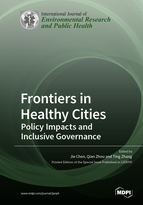Frontiers in Healthy Cities: Policy Impacts and Inclusive Governance
A special issue of International Journal of Environmental Research and Public Health (ISSN 1660-4601). This special issue belongs to the section "Environmental Earth Science and Medical Geology".
Deadline for manuscript submissions: closed (30 June 2022) | Viewed by 83685
Special Issue Editors
Interests: housing policy; housing market; urban development; urban governance
Special Issues, Collections and Topics in MDPI journals
Interests: urban and regional economics; industrial economy
Special Issues, Collections and Topics in MDPI journals
Special Issue Information
Dear Colleagues,
Today, the proportion of human beings that live in cities has exceeded 56 percent, and this number is increasing every year. By 2050, 70 percent of the world’s population will live in cities. While cities provide many opportunities for human being development, however, they also pose unique health risks. The contagious disease COVID-19 disproportionately affecting the urban world today has strongly urged policymakers worldwide to put health high on the social, economic, and political agenda of city governments. As put by the World Health Organization (WHO) in a recent statement, a healthy city is defined by a process, not an outcome. The WHO also defines healthy cities as a process to strive to create social and physical environments which empower people to mutually support each other in both getting on with daily life and reaching their maximum potential. The planning and design of urban space, building environment, and community structure have been found to be critical elements in the formation of a healthy city. However, to ensure health justice, people’s involvement and inclusion in the governance of urban health issues are also crucial. To promote knowledge advances in the formation and governance of healthy cities, we are organizing this Special Issue on “Frontiers in Healthy Cities: Policy Impacts and Inclusive Governance” in the peer-reviewed scientific International Journal of Environmental Research and Public Health.
We are pleased to announce that the Special Issue is open to submissions, and the deadline for submissions is the end of April 2022. This Special Issue aims to publish high-quality, rigorously peer-reviewed, cutting-edge original research applying a multi-disciplinary academic approach to study how to improve environment quality and healthy living in contemporary and future urban environments. It welcomes submissions on a broad range of topics: scientific and technical information on environmental health and healthy living in the urban settings; knowledge around health effects related to urbanization, urban development, and urban renewal; empirical works on the sociocultural, political, economic, and health impacts of policies and interventions aiming to improve the health of living styles; assessments on the distributional characteristics, equality. and justice of health services and facilities in cities; and theoretic or evidence-based explorations on the effectiveness, people’s inclusion, and improvement directions of the governance of healthy cities. The multidisciplinary open-access SI will help to disseminate and communicate scientific knowledge and impactful discoveries of how to make healthy cities to researchers, academics, and the general public globally. We will strive to collect at least 10 articles, and if this number is reached, the Special Issue may be printed in book format.
In this Special Issue, original research articles and reviews are welcome. All papers will be subject to the standard peer-review process. Research areas may include (but are not limited to) the following:
- Frontiers and reviews on the relationship between health and the urban environment;
- Analysis on planning actions that focus on improving the urban population's health;
- Impact assessments on issues such as green areas, mobility, sports, and social cohesion arguably associated with healthy urban living styles;
- Cases on how scientific findings can be translated into prevention strategies and health policies;
- Theoretic explorations or case studies on the governance of urban health facilities and services;
- Theoretic or empirical analysis of people’s inclusion, equality, and justice in the governance of urban health issues.
We look forward to receiving your contributions.
Prof. Dr. Jie Chen
Prof. Dr. Qian Zhou
Dr. Ting Zhang
Guest Editors
Manuscript Submission Information
Manuscripts should be submitted online at www.mdpi.com by registering and logging in to this website. Once you are registered, click here to go to the submission form. Manuscripts can be submitted until the deadline. All submissions that pass pre-check are peer-reviewed. Accepted papers will be published continuously in the journal (as soon as accepted) and will be listed together on the special issue website. Research articles, review articles as well as short communications are invited. For planned papers, a title and short abstract (about 100 words) can be sent to the Editorial Office for announcement on this website.
Submitted manuscripts should not have been published previously, nor be under consideration for publication elsewhere (except conference proceedings papers). All manuscripts are thoroughly refereed through a single-blind peer-review process. A guide for authors and other relevant information for submission of manuscripts is available on the Instructions for Authors page. International Journal of Environmental Research and Public Health is an international peer-reviewed open access monthly journal published by MDPI.
Please visit the Instructions for Authors page before submitting a manuscript. The Article Processing Charge (APC) for publication in this open access journal is 2500 CHF (Swiss Francs). Submitted papers should be well formatted and use good English. Authors may use MDPI's English editing service prior to publication or during author revisions.
Keywords
- Healthy cities
- Environmental health
- Public health
- Healthy living
- Urban resistance
- Urban sustainability
- Urban governance
- Health policy
- Healthy community







